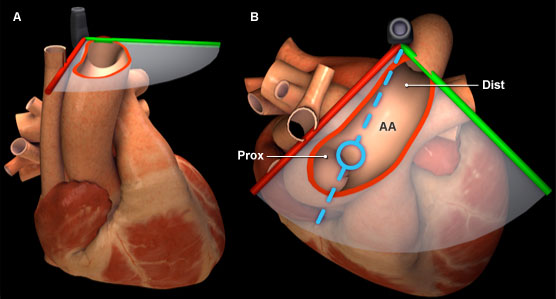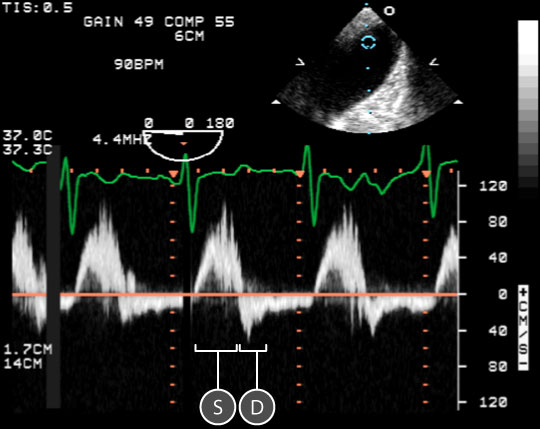Spectral Doppler: Aortic Arch
Obtaining the spectral Doppler
- Identify the aortic arch in the upper-esophageal aortic arch long axis (LAX) view:
- Place the pulsed wave (PW) sample volume through the centre of the proximal or distal aortic arch (figure 1).

Figure 1: Three-dimensional heart model shown in cross-section to highlight the position of the TEE plane in the upper esophageal long axis (LAX) view. A) Antero-superior view of the heart with TEE plane. B) Superior view of the heart and TEE plane. The blue dotted line represents the orientation of the pulsed wave cursor and the blue circle indicates the position of the sample box positioned over the proximal aortic arch. Key: AA = Aortic arch, Dist = Distal aortic arch, Prox = Proximal.
Features of aortic arch spectral Doppler

Figure 2: Spectral doppler data acquired for blood flow through the distal aortic arch. In the upper right, a two dimensional TEE image of the upper esophageal aortic arch long axis (LAX) view; the blue circle indicates the location of the sample volume over the distal portion of the aortic arch. In the lower half of the image, a spectral doppler trace shows the relationship between blood velocity and time. The baseline is orange. NOTE: This spectral Doppler shows diastolic (D) flow below the baseline due to mild aortic insufficiency. Key: S = Systolic wave, D = Diastolic wave.
- A spectral Doppler trace of a normal aortic arch has a single systolic (S) wave seen above the baseline, as blood flows toward the transducer (figure 2).
- The aortic arch Maximum velocity (VAoArch) is 100 cm/sec.
Physiological variation
Pathological variation
- Aortic insufficiency
- Aortic dissection
